Exploring the Art and Challenge of Wakeboarding and Kitesurfing
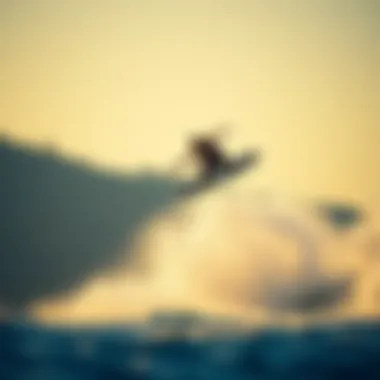
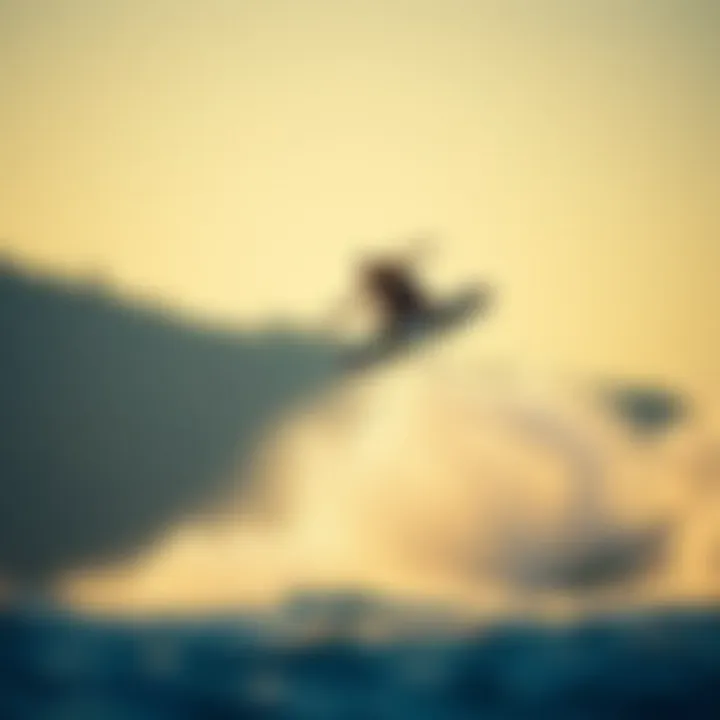
Intro
The thrill of speeding across the water on a wakeboard or kitesurfing can spark an unquenchable fire in any water sports enthusiast. Both activities, while sharing a love for harnessing the power of water and wind, offer unique experiences that cater to different audiences. Understanding the nuances between wakeboarding and kitesurfing can elevate one's ability to enjoy these sports more, whether you're just starting or looking to refine your technique.
As we dive into this exploration, we will touch upon all essential aspects, including gear selections that can make or break your experience, the techniques essential for mastering tricks, and the stark yet fascinating cultural identities that these sports have developed over time.
Gear Insights
In the world of water sports, selecting the right gear can significantly enhance performance and safety. Knowing what equipment works best for you is as important as learning techniques and safety practices.
Latest Gear Reviews
As of late, there have been some notable developments in the gear available for both wakeboarding and kitesurfing that can help you navigate these sports with higher efficiency. New wakeboards, for instance, sport a variety of shapes and sizes tailored for various skill levels and styles. Boards with channels and a more aggressive rocker line allow for a controlled, smooth ride which is ideal for beginners and seasoned riders alike. On the kitesurfing front, advancements in kite designs and materials have made them much lighter and significantly more responsive, catering to a wide range of wind conditions. For example, the Duotone Rebel is very well-regarded for its versatility in different wind conditions.
Essential Gear for Beginners
Starting out in either sport can be daunting, but the right gear helps build confidence. Here's a look at the essentials:
- Wakeboarding:
- Kitesurfing:
- A beginner-friendly wakeboard like the Liquid Force Trip or Ronix Vault, which offers stable platforms.
- Proper bindings that snugly hold your feet for a comfortable ride.
- A life jacket that fits properly for safety on the water.
- Choose a kite suited for lighter winds, such as the Slingshot Teddy, which is forgiving and easy to control.
- A reliable harness, such as the ION Riot, to ensure a secure fit.
- A board that matches your skill level, ideally something like the Nobile NHP that provides stability.
Techniques and Tips
Mastering wakeboarding and kitesurfing involves a blend of skill, patience, and a healthy respect for safety practices. Understanding how the gear interacts with water conditions and wind dynamics can vastly improve your performance.
Advanced Tricks and Techniques
For those looking to push their skills further, mastering advanced tricks is an exhilarating next step. In wakeboarding, tricks like the backflip and 360 spin require good air awareness and timing when taking off from the wake. Similarly, in kitesurfing, mastering the jump and various grabs can considerably elevate your game and impress your peers. To achieve all this, continuous practice is key, along with studying videos and getting feedback from instructors.
Safety Practices for Kiteboarders
Safety should always be the top priority when engaging in any extreme sport. For kiteboarders, understanding wind conditions is crucial; higher winds can lead to accidents if you're not ready. Wearing safety gear such as impact vests and helmets can also assist in preventing injury. Moreover, familiarizing yourself with local laws and regulations is essential, as different areas have their own rules regarding kiteboarding.
"The right equipment and knowledge not only enhance your experience but help you ride safely and confidently."
Joining a local community can serve as a valuable resource for both knowledge and friendship. Many clubs and online forums provide a wealth of information, and connecting with fellow enthusiasts can open doors to mentorship opportunities.
For more on gear updates and community tips, consider checking out resources like Reddit's Wakeboarding Community or visiting Kitesurfing Lessons for expert guidance.
Whether you find yourself zipping across the water at high speeds or gliding gracefully through the air, developing a comprehensive understanding of both wakeboarding and kitesurfing can undoubtedly enrich your experience. With the right gear and techniques, immersing yourself into these thrilling sports opens doors to a vibrant community and adventure.
Prelims to Wakeboarding and Kitesurfing
When we look at the captivating world of water sports, two names often rise to the surface: wakeboarding and kitesurfing. While both can give you that adrenaline rush and a taste of freedom, they offer unique experiences that are quite different from one another. The importance of diving into these sports goes beyond just the surface thrill; it involves understanding the nuances that make each sport appealing.
Wakeboarding provides a blend of surfing and snowboarding with the added excitement of being pulled by a boat. This thrilling sport allows riders to carve through water and perform tricks, making it a visually stunning display of athleticism. Kitesurfing, on the other hand, incorporates the power of the wind. It allows riders to harness this natural force using a kite and a board, presenting an entirely different set of challenges and rewards. Understanding these distinctions draws a clearer picture of the artistry and technical abilities involved in each sport.
Engaging in wakeboarding or kitesurfing also offers noticeable health benefits. Both sports provide an excellent workout, improving balance, strength, and coordination. Additionally, they push individuals to face their fears and conquer challenging environments, ultimately fostering confidence and resilience.
There are several considerations new practitioners should think about, such as safety practices, local regulations, and choosing the right conditions for their experience. Each sport requires knowledge of the environment to enhance not only enjoyment but also safety. By embedding ourselves in these aspects, we set the groundwork for a fruitful exploration of wakeboarding and kitesurfing.
Thus, as we dive into the realms of wakeboarding and kitesurfing, a thorough comprehension of their definitions and historical contexts will set the stage for a more profound understanding of the art and challenge of these exhilarating activities.
Defining the Sports
The essence of wakeboarding can be distilled into its very definition: it's a sport where individuals ride a wakeboard over the surface of the water. A wakeboard is similar to a snowboard but is designed specifically for water. Riders are towed behind a boat, using the generated wake to perform jumps, tricks, and neat maneuvers. The gear usually includes a board, bindings, and a tow rope, along with protective gear like a life vest and helmet.
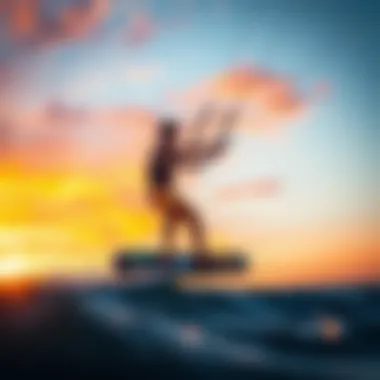
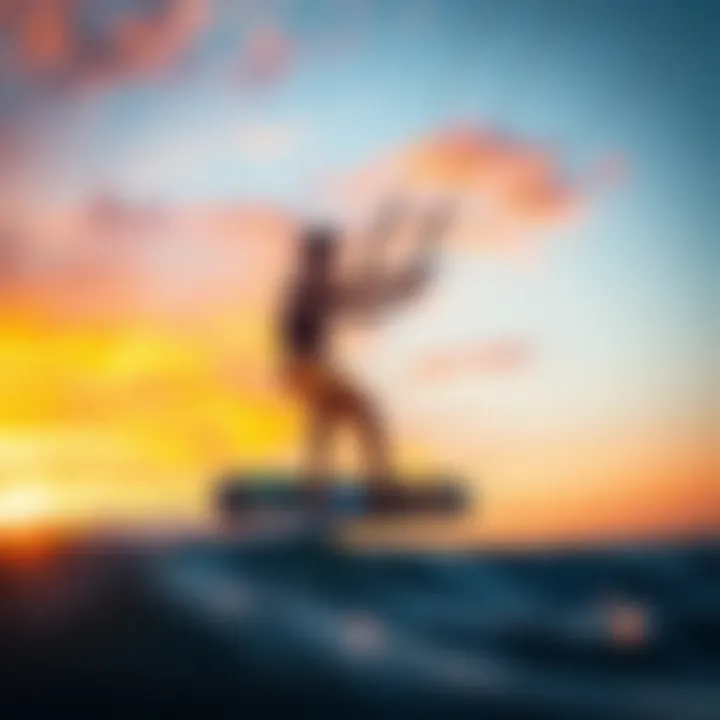
Kitesurfing, or kiteboarding, takes a slightly different route. It combines aspects of surfing, wakeboarding, and paragliding, where participants use a traction kite to pull themselves across the water on a board. The interaction with wind currents provides a unique experience, often allowing riders to jump higher and tackle different surfing styles. The essential gear for kitesurfing comprises the kite, control bar, lines, board, and safety equipment.
Both sports embody a culture of challenge and creativity while sharing core principles around board riding but diverging in the methods of propulsion and the experience on the water.
Historical Context
The roots of wakeboarding can be traced back to the late 1980s, when riders began to experiment with combining surfing and waterskiing. It quickly evolved from a recreational activity into a competitive sport. The establishment of wakeboarding brands, as well as competitions, helped to solidify its place in the world of water sports.
Kitesurfing's history is somewhat more complex, originating from the works of inventors experimenting with kites for traction. It gained traction in the 1990s, propelling enthusiasts onto the global stage. Over the years, kitesurfing has grown significantly, with active communities forming around beaches known for wind and waves.
Both sports have seen advancements in technology over time—equipment has become lighter, more durable, and easier to use, making them more accessible to novices while enhancing the performance of seasoned riders. Understanding where these sports stemmed from enriches the present-day practice and appreciation.
"Exploration of history not only enhances the sport but also connects us to the community of riders who came before."
Equipment Essentials
Understanding the right equipment is pivotal in the worlds of wakeboarding and kitesurfing. Both sports demand a specialized set of gear that not only enhances performance but also ensures safety and enjoyment. Selecting the proper equipment can make the difference between a fantastic day on the water and a frustrating experience.
Wakeboard Gear Overview
In wakeboarding, the gear primarily consists of the wakeboard, bindings, and boots. The wakeboard itself comes in various shapes and sizes, each designed for different styles of riding. For instance, a shorter board tends to be more maneuverable, making it ideal for tricks, while a longer board offers stability, great for beginners.
Bindings hold riders securely to the wakeboard, and they play a significant role in providing comfort and performance. Two main types of bindings exist: open-toe and closed-toe.
- Open-toe bindings are more flexible and adjustable, accommodating various foot sizes.
- Closed-toe bindings provide extra support and are typically made for those looking to perform at a higher level.
Key Points about Wakeboard Gear:
- Safety first: A helmet is always recommended, along with a personal flotation device (PFD) to ensure safety during rides.
- Customization: Many wakeboarders opt for gear that matches their skill level and style, ensuring a tailored experience.
Kiteboarding Equipment Breakdown
Kiteboarding requires a different set of tools, focusing heavily on the kite and board. The main components include the kite itself, harness, control bar, and board. Selecting the right kite size, for example, depends on wind conditions and rider weight.
- Kite Size: Generally, larger kites catch more wind, making them suitable for lighter wind days, while smaller kites are tailored for strong winds.
- Control Bar and Harness: The control bar connects the kite to the rider and is crucial for steering and managing power. A well-fitted harness distributes the load evenly across the body, facilitating better control and comfort.
- Board Selection: Similar to wakeboards, kiteboards come in different styles such as directional boards aimed at surfing and twin-tips made for jumping and tricks.
Considerations for Kiteboarding Gear:
- Test Before You Buy: If possible, try out different gear to find what feels best for your skill level and riding style.
- Quality Matters: Investing in high-quality gear can often lead to a safer and more enjoyable ride, significantly affecting performance.
Comparative Analysis of Gear
When we compare wakeboarding and kiteboarding equipment, several distinctions become clear. While both sports require a board, the nature of the boards and their uses differs greatly. Wakeboards have a fixed fin structure and typically receive power from a boat, while kiteboards rely on the wind and may possess removable fins or no fins at all.
Here’s a breakdown of the key differences:
| Aspect | Wakeboarding Equipment | Kiteboarding Equipment | | Power Source | Boat | Kite | | Board Design | Short and wide for stability | Varies greatly; twin-tip and directional | | Harness Type | Not used in most cases | Essential for control and support | | Learning Curve | Moderate due to boat hold | Steeper; requires wind understanding |
"Choosing the right gear in both sports is as critical as nailing the perfect technique. A mismatch can lead not only to poor performance but also to increased risk of injury."
Ultimately, whether you are ready to carve through the wake or fly with the wind, understanding the essentials of each sport's equipment can lead to a more fulfilling experience on the water.
Techniques and Skill Development
In the world of wakeboarding and kitesurfing, honing one’s techniques and developing skills is crucial. Mastery of fundamental techniques directly impacts performance and safety in both sports. Each sport presents its own set of challenges and requires unique skill sets. For those venturing into these water sports, a solid foundation of techniques not only enhances enjoyment but also instills confidence, allowing riders to push their limits safely.
Understanding the nuances of body positioning, board control, and water conditions is vital. For instance, in wakeboarding, keeping a low center of gravity stabilizes your ride, while in kitesurfing, managing the kite’s power and direction is key to smooth navigation. Without proper technique, riders may struggle to maintain balance, increase the risk of injuries, or miss out on the exhilarating experiences these sports provide. Moreover, refining techniques over time leads to a natural progression in skill levels, inviting enthusiasts to explore advanced maneuvers and tricks.
Basic Wakeboarding Techniques
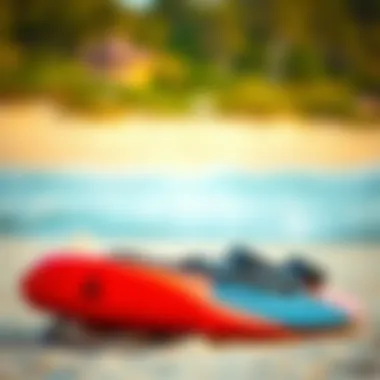
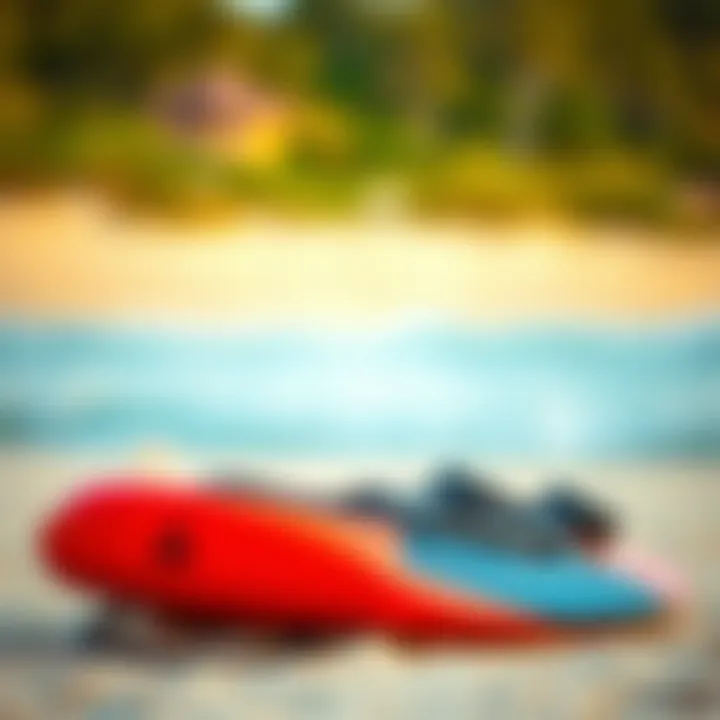
When diving into the fundamentals of wakeboarding, several key techniques stand out.
- Positioning: Being in the right stance at the outset is essential. Riders should begin with their knees bent, housing a position as they prepare to carve through the water. This position allows for better balance and reaction time.
- Cutting: Once comfortable, learning to cut through the wake using your body weight comes next. Riders lean back while edging the board towards the wake, which lifts them out of the water. The goal is to create enough speed before the jump.
- Jumping: This technique consists of executing a simple jump off the wake by popping the tail of the board, extending the legs, and rotating in mid-air. As riders get accustomed to this, they can experiment with grabs and spins, but it’s critical to maintain focus on landing properly.
- Stance Control: Staying aware of one's body alignment while in motion is vital. Focus on keeping shoulders square, as this allows for more fluid maneuvers and prevents unnecessary falls.
Fundamentals of Kitesurfing Technique
Kitesurfing has its own core set of skills that is essential for new riders.
- Kite Control: Understanding how to manipulate the kite is foundational. Practitioners must learn to fly the kite smoothly, using both the bar and lines. The kite functions as the engine; thus correct input in handling it can be the difference between struggling and cruising comfortably.
- Body Dragging: Before getting on the board, body dragging assists in understanding how to control the kite while in the water. Riders learn to navigate by dragging their bodies while holding onto the kite's control bar.
- Water Start: This is a crucial transition where riders go from sitting in the water to standing on the board. Getting the right timing – when to pull on the bar and keep an eye on the kite’s position – is particularly challenging but necessary for progression.
- Rider Positioning: Adopting proper body positioning is everything. A strong, balanced stance ensures that kitesurfers maintain control both over the kite and board, leading to better rides and fewer wipeouts.
Skill Progression in Both Sports
As participants spend more time on the water, they naturally gravitate towards skill progression. The path varies for each individual, shaped by their comfort level and commitment.
- Set Goals: Clear objectives build motivation. Whether it's learning a new trick or mastering a technique, having concrete goals can significantly elevate progress.
- Practice: Consistency is paramount. Riders should allocate time to practice various techniques repeatedly. For instance, regularly practicing jumps in wakeboarding or kite control in kitesurfing can lead to noticeable advancements.
- Feedback: Seeking feedback from experienced riders or instructors provides valuable insights. They can identify areas of improvement or offer tips that make a big difference.
- Community Engagement: Immersion in local communities can foster motivation. Engaging in friendly competitions or simply riding with others can elevate skills while keeping the experience enjoyable.
"The ocean's umbra and the prowess of your abilities complement each other. Progress demands patience, engagement, and a dash of courage."
Embracing a journey of techniques and skill development in wakeboarding and kitesurfing ultimately uncovers the deeper pleasure these sports bring. The thrill is not merely in speed or tricks but in the mastery of oneself against the water's whims.
Safety Practices
Safety is paramount in both wakeboarding and kitesurfing. These thrilling sports, while exhilarating, come with their own set of risks that necessitate precautions. Understanding and adhering to safety practices not only protects participants but also enhances their overall experience. This section delves into the essential safety guidelines, risk management strategies, and emergency protocols that every practitioner should know.
Wakeboarding Safety Guidelines
When you’re flying over the water attached to a board, safety should always be front and center. Here are some key guidelines to keep in mind:
- Wear a Life Jacket: This might seem like a no-brainer, but it’s the first step in ensuring safety. A buoyancy aid not only keeps you afloat but also provides visibility for boat drivers.
- Know Your Surroundings: Familiarize yourself with the area; be vigilant for potential obstacles like boats, rocks, or swimmers. It’s crucial to have an awareness of the environment around you, especially if you’re a newcomer to a particular lake or river.
- Communicate with the Driver: Establish clear signals with your boat driver. A simple thumbs-up can mean you’re ready, while an arm waved could indicate you need to stop. Miscommunication can result in accidents.
- Check Your Gear: Before you hit the water, inspect your equipment for any signs of wear or damage. A faulty binding or rope can lead to serious accidents.
- Practice Fall Safely: Falling is part and parcel of wakeboarding. Learn to fall sideways instead of forward or backward, minimizing the risk of injury.
Kitesurfing Risk Management
Kitesurfing presents its own unique challenges and risks. Implementing effective risk management measures is crucial for a safe experience:
- Weather Awareness: Always check the wind speed and weather conditions before heading out. High winds may be perfect for seasoned riders but can be dangerous for beginners. Have a plan to get off the water if conditions deteriorate.
- Proper Equipment: Ensure your kite is suitable for the current conditions. Using a kite that’s too large for the wind can lead to loss of control.
- Launching and Landing: Be aware of the launch and landing zones, keeping them clear of people and obstacles. Practice these skills until you feel completely confident.
- Buddy System: Kite with a partner whenever possible. Not only does this allow for better support, it can also increase safety as you share responsibilities in observing conditions and each other’s well-being.
- Self-Rescue Techniques: Familiarize yourself with self-rescue techniques. Knowing how to handle unexpected situations, such as getting tangled in your lines, is essential.
Emergency Protocols
Despite all precautions, accidents can and do happen. Being prepared is key to ensuring that minor incidents don’t escalate into serious emergencies.
- First Aid Kit: Always have a first aid kit on hand while participating in these sports. Having basic supplies can make a big difference, especially in remote areas.
- Communication Devices: Invest in a reliable communication device, such as a waterproof phone or radio. This can be crucial for calling for help if an accident occurs.
- Know Local Emergency Services: Be aware of local emergency services and their contact information. This knowledge can save precious time in critical situations.
- Establish a Safety Plan: Have a planned response for emergencies. Discuss with your group what to do in case of an accident, including designated roles.
- Stay Calm: In the face of an emergency, keeping a level head can be incredibly helpful. Panic often exacerbates the situation and can lead to poor decision-making.
"By prioritizing safety, you not only protect yourself but also contribute to a safer environment for everyone involved in wakeboarding and kitesurfing."
Conditions and Locations
Understanding the conditions and locations suitable for wakeboarding and kitesurfing is fundamental to achieving a rewarding experience in both sports. Weather factors such as wind patterns, water conditions, and geographical features play a significant role in the safety and enjoyment of these activities. Knowing where to go and what to expect creates not just a better environment for practice but also enhances overall performance.
Best Locations for Wakeboarding
When it comes to wakeboarding, choosing the right location can make all the difference. Popular spots often have consistent water conditions, allowing for smoother rides. Here are some prime examples:
- Lake Powell, Utah: A mecca for wakeboarders, this expansive lake offers calm waters and stunning red rock formations.
- Lake Havasu, Arizona: A hotspot for a variety of water sports, it’s known for its beautiful scenery and vibrant atmosphere.
- Maui, Hawaii: Though known for its surfing, Maui has spots where wakeboarding flourishes, providing promises of adventure amidst picturesque views.
Factors to consider while choosing a wakeboarding location include accessibility, water clarity, and the presence of facilities like marinas and gear rental shops. These enhancements can significantly affect your overall experience.
Ideal Kitesurfing Conditions
Kitesurfing thrives in specific conditions that are quite a bit different from wakeboarding. Wind speed and consistency are key. Here’s what to look for:
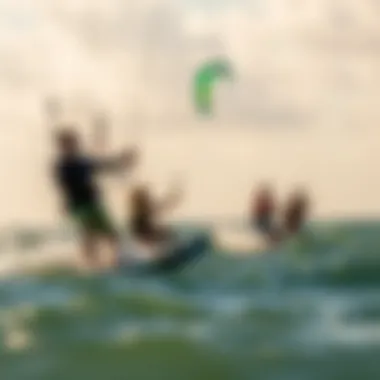
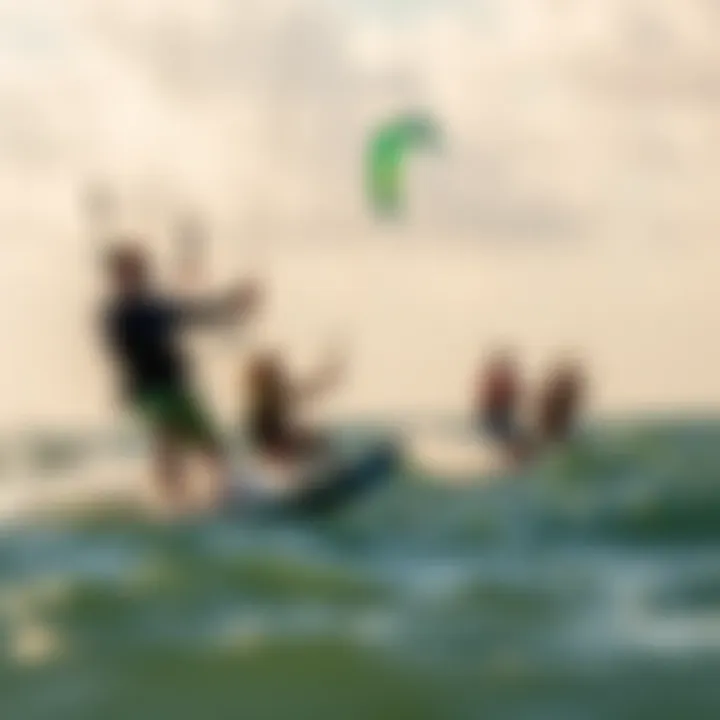
- Steady Winds: The ideal wind range is between 12 to 25 knots. Too little wind can leave you stuck, while too much can be dangerous.
- Open Water: Areas free from obstructions, like rocks and boats, are crucial to ensure safety while kiting.
- Flat Water and Waves: Depending on your skill level and interest, you may prefer flat water for tricks or wave spots for slicing through surf.
Some of the best global kitesurfing locations include:
- Cape Town, South Africa: Renowned for its consistent winds and beautiful ocean vistas.
- Tarifa, Spain: Known as the kitesurfing capital of Europe, with diverse wind conditions that cater to all skill levels.
- The Great Barrier Reef, Australia: Offers a unique kitesurfing experience surrounded by breathtaking marine life.
Environmental Awareness for Both Sports
Both wakeboarding and kitesurfing can have an impact on the environment. Thus, environmental awareness is paramount. Here are some practices to consider:
- Respect Local Wildlife: Avoid areas where animals, especially nesting birds, are present.
- Be Mindful of Local Regulations: Many places have designated areas for water sports to minimize conflicts with wildlife and other water users. Check local guidelines, for example at websites like *.gov.
- Leave No Trace: Ensure that you take all your trash back with you. Simple actions can contribute to preserving the beauty of the locations we love.
"Let’s not forget: the beauty of these activities lies not just in the rush of adrenaline but also in the respect we bestow upon the environments that host them."
Being conscious of your impact on the environment elevates the sport and promotes sustainable practices within the community.
Community and Culture
Exploring the community and culture surrounding wakeboarding and kitesurfing provides a deeper understanding of these sports. They are not merely activities; they are vibrant networks of friendships, shared experiences, and collective growth. Both sports operate within ecosystems that promote learning, safety, and camaraderie. This section delves into the nuances of these communities, their dynamics, and how they enhance the overall experience.
The Wakeboarding Community
The wakeboarding community is a tight-knit group where connections run deep. This culture thrives on shared passion and learning, where newcomers are welcomed with open arms. Local lakes and cable parks often become hubs of activity, with enthusiasts flocking to watch and support one another.
Key elements of the wakeboarding community include:
- Inclusive Atmosphere: Seasoned riders often take the time to coach beginners. This mentorship cultivates skill development and creates a sense of belonging.
- Social Events: Regular gatherings, whether informal jam sessions or organized competitions, foster camaraderie. Riders share tips, celebrate achievements, and build friendships that often extend beyond the water.
- Online Presence: Platforms like Reddit (https://www.reddit.com/r/wakeboarding/) and various Facebook groups are bustling with discussions, tips, and community challenges, connecting wakeboarders even when they can’t be out on the water.
In this environment, riders not only push each other's limits but also grow as individuals.
Kitesurfing’s Global Network
Kitesurfing boasts a global network that is both diverse and connected. With enthusiasts spread across continents, each region contributes its unique flair to the sport. From the windy beaches of Tarifa in Spain to the tropical shores of Maui, kitesurfers build bridges that transcend cultural barriers.
The significance of this global network can be highlighted in several ways:
- Cultural Exchange: Every destination has its own approach to kitesurfing. Riders exchange techniques, styles, and stories that enrich the sport. Learning a few local phrases can even enhance the experience at international spots.
- Travel and Adventure: Many kitesurfers travel extensively to find the best conditions. This journey fosters a sense of wonder and excitement in discovering new cultures and landscapes. It encourages environmental awareness as they engage with and enjoy their surroundings.
- International Competitions: Events like the Red Bull King of the Air not only showcase talent but also bring together a community of enthusiasts. These gatherings function as melting pots of ideas and techniques, setting the stage for evolution within the sport.
This interconnection makes Kitesurfing more than just a pastime; it’s a globally interconnected lifestyle.
Events and Competitions
Events and competitions play pivotal roles in both wakeboarding and kitesurfing cultures. They serve as platforms for riders to showcase their skills, push boundaries, and connect with fellow wave enthusiasts. Whether local or international, these gatherings are crucial in shaping the identity of the sports.
Consider the following points when examining these events:
- Skill Showcases: Competitions highlight talented riders and serve as inspiration for others. Watching experienced athletes perform tricks can ignite the passion in newcomers, pushing them toward mastery.
- Community Building: Events foster a sense of unity within the sport. Wakeboarders or kitesurfers from various backgrounds come together, share experiences, and build lasting relationships.
- Networking Opportunities: Competitions often attract sponsors, media, and industry professionals. This visibility can open doors for riders looking to take their passion to the next level.
Culmination: Embracing Both Worlds
In our exploration of wakeboarding and kitesurfing, it's clear that both sports are more than just thrilling activities; they provide a distinct blend of challenge, community, and connection to the water. The significance of embracing both worlds lies not only in the unique experiences each sport offers but also in the ability to enhance skills and deepen one’s appreciation for water sports as a whole.
Synthesizing the Experiences
The experiences found in wakeboarding and kitesurfing, while remarkably different in execution, share a common thread of empowerment and freedom. To synthesize the experiences means to recognize how each sport complements the other, often bringing practitioners together in shared communities. For instance,
the balance and coordination developed in wakeboarding can bolster one’s kitesurfing skills. Conversely, the mastery of kite control in kitesurfing nurtures agility that translates back to further advancements in the wakeboarding arena. This cross-pollination of skills creates a rich tapestry of water sports enjoyment. Both sports demand an understanding of conditions—wind for kitesurfing and water for wakeboarding—teaching enthusiasts adaptability and respect for nature's forces.
"Whether you’re carving through glassy lake surfaces or soaring above ocean waves, there’s a unique satisfaction in mastering such challenging sports."
Beyond skills and techniques, the shared culture of both sports fosters camaraderie. Many enthusiasts find themselves participating in competitions or regional meet-ups that fuel excitement and inspiration in their respective communities. Cameras are often ready for capturing those heart-stopping moments—flips, twists, and leaps—creating memories that are best shared with like-minded individuals who appreciate the thrill.
Future of Wakeboarding and Kitesurfing
Looking ahead, the future of wakeboarding and kitesurfing is bright, with technologies continuing to advance, making the sports more accessible and exciting. Innovations in equipment—such as lighter boards, more efficient kites, and advanced safety gear—are on the rise. These developments will likely encourage more people to join the ranks of enthusiasts.
Environmental sustainability will also shape the future of these sports. As awareness of ecological issues grows, so does the push for environmentally-friendly practices both on the water and during travel to favorite spots. Organizations dedicated to preserving our natural environments are essential for promoting responsible and sustainable engagement in water sports. As more athletes rise to the occasion, melding their passion with conservation, we can hope to see a positive impact on the ecosystems that support our beloved activities.















